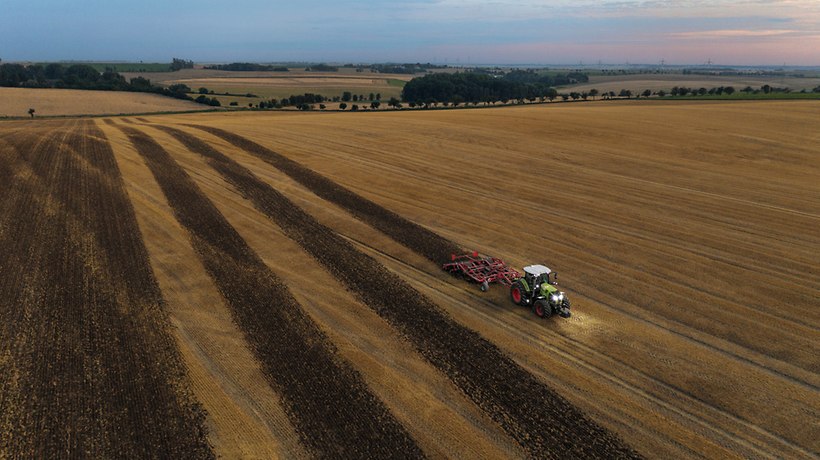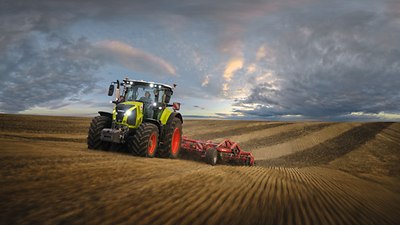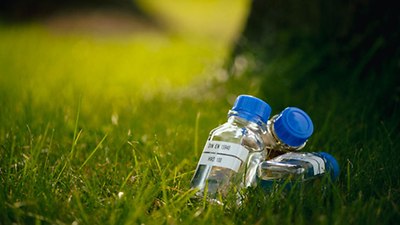
CLAAS POWER SYSTEMS
With CLAAS POWER SYSTEMS we maximise efficiency by ensuring that all drive components are perfectly matched.

A rethink is needed if agriculture is to operate more sustainably. To effectively reduce CO2 emissions, we must consider all alternative drive options – and give serious thought to which technologies will be viable in the long-term.
As an agricultural machinery manufacturer, CLAAS aims to provide efficient, sustainable solutions – because farming can only work in harmony with nature. At the same time, we believe in maintaining a balance and taking seriously the cost pressures facing farmers. For this reason, we are constantly assessing innovations to determine which are practical, climate-friendly and financially viable.
According to the German Federal Environment Agency, "mobile and stationary combustion", which includes emissions from agricultural machines, accounted for one tenth of agricultural greenhouse gas emissions in 2021. This equates to around 0.9% of total emissions in Germany. Although this may seem a modest amount, at CLAAS we are taking an open-minded approach and considering all options to further reduce it. Three alternative drives are under discussion: battery-electric solutions, hydrogen drives and environmentally friendly liquid fuels. We explain the pros and cons of these three approaches and their possible uses.
Battery-electric drives are well-established in passenger transport and have proved a viable alternative to the combustion engine for every day use. They can also be used to good effect in some agricultural areas; for example, a battery-electric small tractor can handle the practical demands of yard work, light fieldwork and municipal work. However, at this stage electric motors are not a workable option for larger, more powerful machines. These machines need higher tractive performance and in some cases their engine has to drive other components apart from the vehicle itself, such as the threshing unit in a combine harvester. This would require an extremely large, heavy battery. An electric tractor with a 135 kW output would need a battery ten times heavier than a conventional engine with diesel tank – making the resulting machine so heavy that it would cause long-term damage to the soil by compacting the substrate as it drove across the field. If the battery capacity was reduced to an acceptable additional weight, its range would be too short to be practical.
However, it would be a mistake to underestimate the pace of technological development. Battery capacities and charging speeds especially have continued to improve in recent years. Although high investment costs for batteries and charging infrastructure will slow their spread initially, financial incentives and the use of affordable, self-generated electricity mean that the investment will pay for itself over several years. Currently, a farmer would need to invest 40,000 euros in their own charging infrastructure.
The use of hydrogen fuel cells as an alternative drive in agriculture is not a realistic proposition at present. Agricultural machines need a large amount of power in a short time – and that's not what fuel cells are designed for. But hydrogen combustion engines could be an option in future. Unlike an electric drive, they would have the advantage of allowing the existing drive train to be largely retained, although a different engine would obviously have to be installed. However, the existing tank capacity would need to increase tenfold to carry the hydrogen required without making frequent stops for refuelling. This additional space requirement would completely change the existing machine architecture. Infrastructure and logistics pose further challenges: an on-farm hydrogen fuel station is extremely expensive to install compared with a diesel tank. At today's prices a farm would have to invest around 800,000 euros. In addition, hydrogen would have to be delivered frequently to the farm, unlike electricity from the power outlet.
'Drop-in' fuels are the most promising drive technologies. The term is derived from the fact that they can be used without having to modify the vehicle. One example is HVO (hydrotreated vegetable oil), made from biowaste and oils. Another is e-fuel (synthetic fuel) made from water and CO2 using electricity. Although the use of drop-in fuels, like conventional diesel, releases CO2 – the same amount of CO2 is removed from the environment to produce them, so they are in effect CO2-neutral. Switching to HVO would be by far the most affordable and effective solution since the existing fleet would reap the benefits. An average farmer would have to invest only around 8,000 euros in a fuel storage tank.
In theory, HVO is already available and by the end of 2023 CLAAS will have approved most of our machines for its use – although fuel stations in Germany are not currently permitted to sell this sustainable alternative to diesel. E-fuels will not be available in sufficient quantities until around 2030. Biodiesel is another environmentally friendly liquid fuel that is already available and in use. However, machines would have to be modified before they could run on this fuel, and there are difficulties associated with its handling and storage.
The good news is that there are many different ways to make agriculture CO2-neutral even in the near future. Some technologies are already available, while others are well on the way to being suitable for agricultural use. The key requirement for a sustainable future is to be open to different technologies. Because an economic sector as complex as agriculture with all its diverse requirements needs approaches tailored to each application. And the first step is to make the existing drive ever more efficient – something we continuously strive to do.
Here at CLAAS we want to increase the efficiency and thus the environmental sustainability of agricultural machines throughout the process chain. As well as researching alternative drives, this includes increasing process efficiency with the help of connected machines, optimising operation using smart automation and boosting machine efficiency.

With CLAAS POWER SYSTEMS we maximise efficiency by ensuring that all drive components are perfectly matched.

While electric cars are taking over the streets, corn choppers, combine harvesters and large tractors will still need internal combustion engines in the future.
Products built on powerful technology – find out more here.